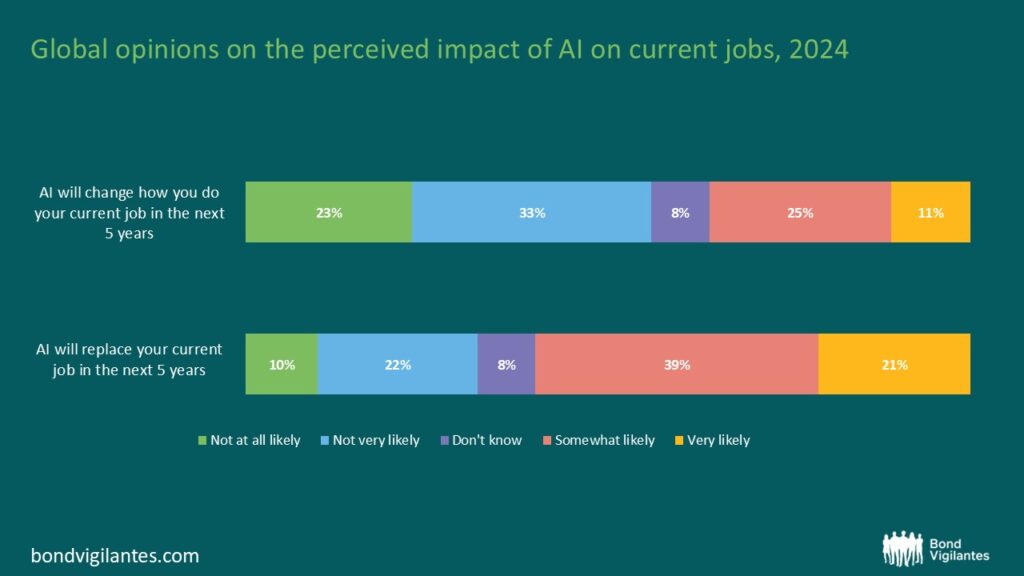The AI revolution: facilitator or terminator?
We’ve all heard the arguments – “AI will supercharge the economy!” versus “No, AI is going to steal all our jobs!” The reality lies somewhere in between. Generative AI1 is a powerful tool that will boost productivity, but it won’t trigger mass unemployment overnight, and it certainly isn’t Skynet (if you know, you know). The International Monetary Fund (IMF) estimates that “AI will affect almost 40% of jobs around the world, replacing some and complementing others”. In practice, that means a large portion of workers will see some tasks automated by AI, but not necessarily lose their entire job. However, even jobs heavily exposed to AI still require human-only inputs and oversight: AI might draft a report, but you’ll still need someone to fine-tune the ideas and make the decisions.

Source: Stanford University “The 2025 AI Index Report”, Ipsos.
From an economic perspective, AI will undoubtedly be a game changer. Nobel laureate Michael Spence wrote in September 2024 that AI “has the potential not only to reverse the downward productivity trend, but over time to produce a major sustained surge in productivity.” In other words, AI could usher in a new era of faster growth by enabling more output from the same labour and capital. Crucially, AI often works best in collaboration with existing worker skillsets; in most industries AI has the potential to handle repetitive or time-consuming work (like basic coding or form-filling), letting people concentrate on higher-value-add aspects. In short, AI can raise output per worker without making workers redundant en masse. This, in turn, has the potential to raise GDP over time; if this occurs in a non-inflationary environment it could outpace the growth in US debt for example.
Some jobs will benefit more than others. Knowledge workers who harness AI – e.g. an analyst using AI to sift data – can become far more productive (and valuable). New roles (AI auditors, prompt engineers) are already emerging. Conversely, jobs heavy on routine information processing are already under pressure. The job of a translator is often cited as the most at risk; for example, today’s AI can already handle c.98% of a translator’s typical tasks, and is gradually conquering more technically challenging real-time translation.
Likewise, some roles may disappear – content writers or customer support roles handling simple Q&As may find AI doing a lot of their work. Their roles will need to evolve to survive, and refocus on creativity or dealing with more complex problem-solving to stay relevant. On the other hand, many manual and in-person jobs remain largely untouched by generative AI. An algorithm can churn out a legal brief, but it can’t fix a leaky pipe or provide nursing care (yet!). Thus, plumbers, electricians, nurses – and others whose work is physical or requires human empathy – are not directly replaceable by a text generator. Ironically, that means many lower-tech jobs are probably safer from AI than certain white-collar ones (until the robots arrive, but that’s for another post).
Here are the top 10 occupations most impacted by generative AI today:
- Interpreters and Translators
- Historians
- Passenger Attendants
- Sales Representatives
- Writers and Authors
- Customer Service Representatives
- Machine Tool Programmers
- Telephone Operators
- Travel Agents
- Broadcast Announcers and Radio DJs
Source: Microsoft Research
In the face of this rapidly evolving change, policymakers aren’t sitting idle. Both in the US and Europe, there’s talk of beefing up retraining programmes, so workers from shrinking fields (say, telesales) can move into growing ones (like tech or healthcare). More speculative ideas like Universal Basic Income (UBI) have been floated were AI ever to cause extreme joblessness, but so far it seems premature – unemployment today is low and AI is filling gaps more than it’s creating them. Regardless, most government deficits and debt would preclude paying everyone UBI. The smarter near-term strategy will be enhanced education and upskilling of the workforce, ensuring people can then work with AI.
Governments might also need to adjust taxation – if corporate profits soar from AI-driven efficiency while wage growth for workers stays sluggish, taxation may need to refocus on capital gains or higher earners to sustain public finances given current fiscal constraints.
For companies, the message is stark: adopt AI or risk obsolescence. The impact will be like a second Industrial Revolution; businesses that adapt to generative AI can cut costs and innovate faster – advertising agencies will auto-generate campaigns, banks will use AI for fraud detection, marketing companies will have micro-profiles of potential buyers. This should lift earnings (higher efficiency, better products), and investors are already rewarding firms with credible AI strategies and anticipating future profits. While this may be a bit premature, firms that ignore the trend will likely find themselves struggling to retain market share and unable to deliver cost-benefits.
Businesses deploying AI blindly will inevitably lead to some costly blunders – from chatbots giving wrong answers, AI that hallucinates and algorithms accessing poor underlying data – could all hurt a company’s reputation and invite regulatory scrutiny. European regulators, for example, have passed the AI Act in 2024, codifying rules to ensure “AI responsibility,” which will have cross-border implications impacting US technology companies operating in Europe. Thus, the corporate sweet spot appears to be enthusiastic but responsible adoption: use AI to get an edge, but put sufficient guidelines in place (human oversight, testing, ethics guidelines) to avoid pitfalls.
For investors, the outlook will remain uncertain. Long-run growth prospects should improve (bullish for equities, and credit quality of companies and sovereigns) provided inflation remains low or stable, which in turn would be bullish for nominal bonds. However, higher productivity would also suggest higher real interest rates (as investment demand increases and economies run hotter). The push and pull between inflation and growth, productivity and employment may see an uncertain decade ahead that sees volatility in rates and curves that provide opportunities for investors.
In summary, generative AI is a disruptor and set to become a transformative force in both economies and businesses. We can expect faster growth, shifting (and new) job opportunities – if we adapt. Rather than a robot apocalypse, it’s shaping up to be a robot-assisted era: companies and workers who work with AI will benefit, while those who can’t or won’t adapt risk going the way of dinosaurs. In the end, jobs might look a bit different, and hopefully a bit more interesting, with AI as your new best friend.
NB The author notes this article was initially generated from an AI summary of the Microsoft research paper “Working with AI: Measuring the Occupational Implications of Generative AI”, along with other subsequent prompts, and was then given the necessary human editorialising. This underlines the point made in the blog: AI can draft a report, but you still (thankfully) need someone to fine-tune the ideas!
1Generative AI refers to a class of artificial intelligence systems that can create new content—such as text, images, audio, video, or code—based on patterns learned from existing data. Unlike traditional AI models that classify or predict, generative models produce original outputs that resemble but do not replicate their training data.
The value of investments will fluctuate, which will cause prices to fall as well as rise and you may not get back the original amount you invested. Past performance is not a guide to future performance.










